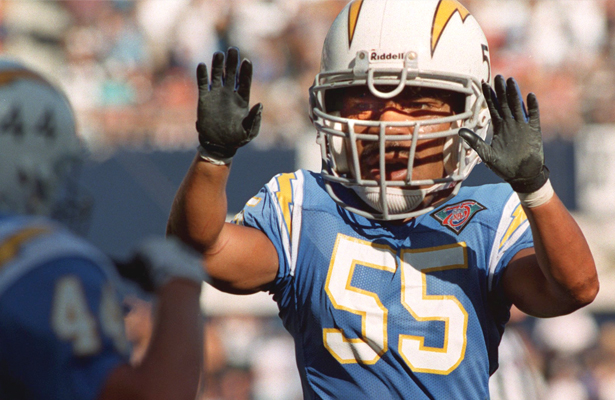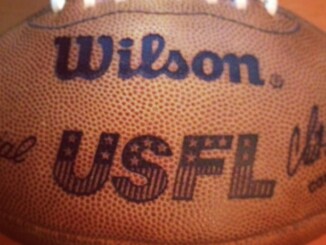
Late Linebacker Junior Seau Headlines the Hall of Fame Class of 2015
By Lance Rinker
One of the most dominant linebackers in National Football League history was expected to be elected into the Pro Football Hall of Fame on Jan. 31. Unfortunately, he will not be there for the ceremony as the game he sacrificed his body for over a 20-year career also took his mind, committing suicide on May 2, 2012 at the young age of 43, the result of giving and receiving too many hits.
Junior Seau was drafted by his home town San Diego Chargers in the first round, the fifth overall pick, of the 1990 NFL Draft. He quickly became the face of the franchise and not just a popular player in Southern California, but all across the league.
He played with the Chargers through the 2002 season, spent 2003-05 with the Miami Dolphins and then signed four-straight one-year contracts with the New England Patriots. He played for the Patriots from 2006-09 and was an integral part in New England’s perfect 2007 regular season, playing in all 16 games and starting four.
“[He’s the] all-time leader in tackling, but more than stats, his love of the game, his passion for the game, and the high level that he played at a very difficult position. I mean, him, Clay Matthews [Jr.], guys to play as long as they did at that position as well as he did is phenomenal. He is so deserving. I hope it happens.” – New England Patriots coach Bill Belichick on whether Junior Seau is deserving of the NFL Hall of Fame
Seau was more than just a man though. He was a part of the smelling salts and get back in there generation of men who would do anything to keep that dream of playing in the NFL alive. The average NFL career barely lasts three years for most players, Seau carved out one hell of a journey over 20.
By the time he was finished he had played in the second-most games by a linebacker in NFL history, was a 12-time Pro Bowler, a six-time First-Team All-Pro, 1992 Defensive Player of the Year, and arguably is the greatest San Diego Charger to ever wear the uniform.
Seau went to those 12 Pro Bowls as a Charger, the most any Charger has been selected in franchise history. Seau also still leads the Chargers all-time in tackles, with 1,478 and averaged 114 tackles per season over his 13-year career with the Chargers.
What made Seau such a goliath to have to deal with on the field was his explosive speed and ability to play out of position, and do it well. His speed made him difficult to match up against and his ability to brush by those charged with blocking him allowed him to do things linebackers of his time weren’t thought capable of. Seau was one of the greatest tacklers, technique and pure strength wise, to don an NFL jersey.
It was not all physical talent that made Seau so desirable to teams and head coaches. His work ethic and strong leadership skills in the locker room made him one of the most coveted players in the NFL. Even after his skills had eroded after two injury-filled years with Miami from 2004-05, he remained a player worth keeping on the roster, as Belichick and the New England Patriots discovered during their undefeated regular season in 2007.
The impact he had during his decade-long peak with the Chargers is inherently obvious, but no linebacker has had more seasons (four) with 80 or more tackles and four or more sacks than Seau. Additionally, only one other linebacker of the modern era has just as many seasons (two) with 80 or more tackles, four or more sacks and two or more interceptions than he, London Fletcher during 2001 and 2002 with the St. Louis Rams. Only one other player, safety Rodney Harrison with three, has had more than two seasons of those accomplishments.
If you were to write a story about the perfect way to end your career, Seau’s would definitely be at the top of the list – the only thing missing was the Super Bowl championship.
Seau helped lead the Chargers to their only Super Bowl appearance in franchise history, losing to the San Francisco 49ers 49-26, after finishing the 1994 season with an 11-5 record. He also helped lead the Patriots to Super Bowl XLII, after going undefeated in the 2007 regular season.
If not for a miraculous, legend-making catch by New York Giants receiver David Tyree in the fourth quarter of that game, it is entirely likely Seau would have had his Super Bowl ring.
Given when Seau played, the fact he’s as high up the record lists as he is for the position he played is somewhat surprising. He played in an era when offensive production wasn’t as inflated as it is today due to rules limiting what defensive players can do.
Nowadays, it is so much easier for linebackers and defensive players to rack up tackles and passes defended statistics because of the nature of the game. You cannot go after the quarterback as much, so you sit and wait to take down the runner or receiver.
That is how players such as Luke Kuechly, Stephen Tulloch and even Patrick Willis have been able to make such a name for themselves. Feasting on the easy pickings of ball handlers and not having to do much more on the field other than that.
No offense to any of those players, as they are all great in their own right. But, if they started their careers as early as Seau did when it was required of them to do extra across the board, I just don’t know if we would still view those mentioned above as some of the best linebackers in the game today the way we did with Seau when he was playing.
One other thing to mention about Seau is he often had to be the man to carry the weight of an entire defense on his shoulders because he was rarely surrounded by other Pro Bowl talent throughout his career.
Seau had that rare quality as a player and as a person to be able to elevate nearly everything about the players and people around him. If that is not the sign of a truly great player, then I’m not sure what is.
Praised by teammates for his work ethic and ability to lead. Playing hurt and refusing to leave games when he could barely walk during practice beforehand.
Hall of Fame quarterback John Elway summed up Seau this way: “He played the game the way it was meant to be played.”
The Chargers honored Seau by naming him to the Chargers 40th and 50th anniversary teams, which honor the top players and coaches in the team’s history. The Chargers also inducted him into the San Diego Chargers Hall of Fame on Nov. 27, 2011, as part of Alumni Day ceremonies during a sold-out game against the Denver Broncos. Former Charger and Hall of Famer Dan Fouts introduced Seau before a crowd of nearly 71,000.
After Seau’s death, Chargers team President Dean Spanos honored Seau by recognizing his charity work and accomplishments in the San Diego community.
“An icon in our community,” Spanos said. “He transcended the game. He wasn’t just a football player, he was so much more.”
The Chargers retired Seau’s No. 55 jersey during his public memorial on Sept. 16, 2012, which was the regular-season home opener for the Chargers against the Tennessee Titans.
His home area also gave back to Seau after his death by renaming certain buildings in his honor. The Junior Seau Pier Amphitheatre and Junior Seau Beach Community Center were renamed posthumously in his honor by the city of Oceanside in July 2012.
The San Diego Hall of Champions inducted Seau into the Breitbard Hall of Fame on Feb. 25, 2013, forgoing the normal two-year waiting period after an athlete’s retirement or death.
After Seau’s death, the HOF’s board of directors was unanimous in accelerating his inclusion in the Class of 2013.
“Some rules,” Fouts said, “are made to be broken.”
No matter the astonishing career statistics, or the many accolades he won throughout his playing career, none of it truly does Seau justice to illustrate the kind of person he was off the field.
One of the first things Seau did after beginning his professional career, once he realized he would be in San Diego with the Chargers for a while, was create the Junior Seau Foundation. The foundation’s purpose was to educate and empower youth in the community through the support of child abuse prevention, drug and alcohol awareness, recreational opportunities, anti-juvenile delinquency efforts, and complimentary educational programs.




